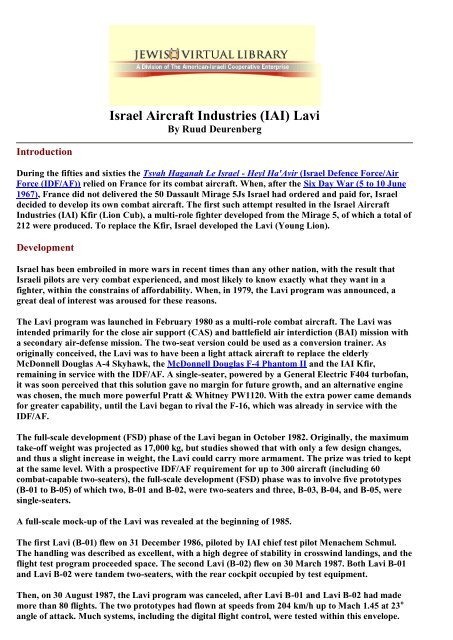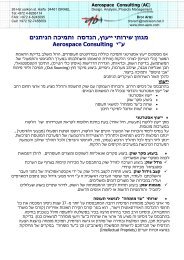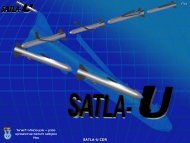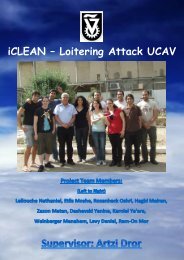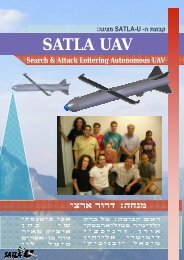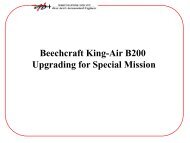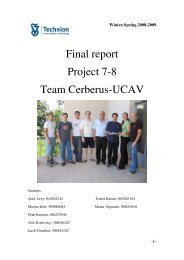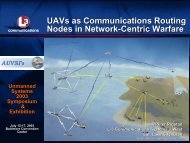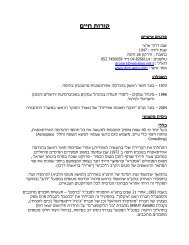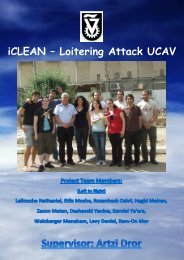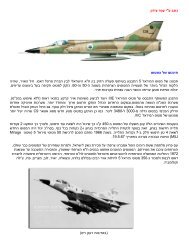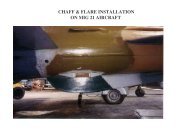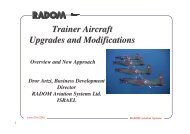Israel Aircraft Industries (IAI) Lavi - aero.com
Israel Aircraft Industries (IAI) Lavi - aero.com
Israel Aircraft Industries (IAI) Lavi - aero.com
Create successful ePaper yourself
Turn your PDF publications into a flip-book with our unique Google optimized e-Paper software.
<strong>Israel</strong> <strong>Aircraft</strong> <strong>Industries</strong> (<strong>IAI</strong>) <strong>Lavi</strong><br />
By Ruud Deurenberg<br />
Introduction<br />
During the fifties and sixties the Tsvah Haganah Le <strong>Israel</strong> - Heyl Ha'Avir (<strong>Israel</strong> Defence Force/Air<br />
Force (IDF/AF)) relied on France for its <strong>com</strong>bat aircraft. When, after the Six Day War (5 to 10 June<br />
1967), France did not delivered the 50 Dassault Mirage 5Js <strong>Israel</strong> had ordered and paid for, <strong>Israel</strong><br />
decided to develop its own <strong>com</strong>bat aircraft. The first such attempt resulted in the <strong>Israel</strong> <strong>Aircraft</strong><br />
<strong>Industries</strong> (<strong>IAI</strong>) Kfir (Lion Cub), a multi-role fighter developed from the Mirage 5, of which a total of<br />
212 were produced. To replace the Kfir, <strong>Israel</strong> developed the <strong>Lavi</strong> (Young Lion).<br />
Development<br />
<strong>Israel</strong> has been embroiled in more wars in recent times than any other nation, with the result that<br />
<strong>Israel</strong>i pilots are very <strong>com</strong>bat experienced, and most likely to know exactly what they want in a<br />
fighter, within the constrains of affordability. When, in 1979, the <strong>Lavi</strong> program was announced, a<br />
great deal of interest was aroused for these reasons.<br />
The <strong>Lavi</strong> program was launched in February 1980 as a multi-role <strong>com</strong>bat aircraft. The <strong>Lavi</strong> was<br />
intended primarily for the close air support (CAS) and battlefield air interdiction (BAI) mission with<br />
a secondary air-defense mission. The two-seat version could be used as a conversion trainer. As<br />
originally conceived, the <strong>Lavi</strong> was to have been a light attack aircraft to replace the elderly<br />
McDonnell Douglas A-4 Skyhawk, the McDonnell Douglas F-4 Phantom II and the <strong>IAI</strong> Kfir,<br />
remaining in service with the IDF/AF. A single-seater, powered by a General Electric F404 turbofan,<br />
it was soon perceived that this solution gave no margin for future growth, and an alternative engine<br />
was chosen, the much more powerful Pratt & Whitney PW1120. With the extra power came demands<br />
for greater capability, until the <strong>Lavi</strong> began to rival the F-16, which was already in service with the<br />
IDF/AF.<br />
The full-scale development (FSD) phase of the <strong>Lavi</strong> began in October 1982. Originally, the maximum<br />
take-off weight was projected as 17,000 kg, but studies showed that with only a few design changes,<br />
and thus a slight increase in weight, the <strong>Lavi</strong> could carry more armament. The prize was tried to kept<br />
at the same level. With a prospective IDF/AF requirement for up to 300 aircraft (including 60<br />
<strong>com</strong>bat-capable two-seaters), the full-scale development (FSD) phase was to involve five prototypes<br />
(B-01 to B-05) of which two, B-01 and B-02, were two-seaters and three, B-03, B-04, and B-05, were<br />
single-seaters.<br />
A full-scale mock-up of the <strong>Lavi</strong> was revealed at the beginning of 1985.<br />
The first <strong>Lavi</strong> (B-01) flew on 31 December 1986, piloted by <strong>IAI</strong> chief test pilot Menachem Schmul.<br />
The handling was described as excellent, with a high degree of stability in crosswind landings, and the<br />
flight test program proceeded space. The second <strong>Lavi</strong> (B-02) flew on 30 March 1987. Both <strong>Lavi</strong> B-01<br />
and <strong>Lavi</strong> B-02 were tandem two-seaters, with the rear cockpit occupied by test equipment.<br />
Then, on 30 August 1987, the <strong>Lavi</strong> program was canceled, after <strong>Lavi</strong> B-01 and <strong>Lavi</strong> B-02 had made<br />
more than 80 flights. The two prototypes had flown at speeds from 204 km/h up to Mach 1.45 at 23 o<br />
angle of attack. Much systems, including the digital flight control, were tested within this envelope.
The third <strong>Lavi</strong> (B-03) and subsequent <strong>Lavi</strong> prototypes (B-04 and B-05) would be fitted with the<br />
definitive wing with increased elevon chord and the last three prototypes would also have the<br />
<strong>com</strong>plete mission-adaptive avionics system. <strong>Lavi</strong> B-04 and <strong>Lavi</strong> B-05 were just about to receive the<br />
definitive wing when the program was canceled.<br />
The first production aircraft were intended to be delivered in 1990 and initial operationally capability<br />
(IOC) was planned for 1992. At the height of the production, a total of twelve aircraft would be<br />
produced in one month. The <strong>Lavi</strong> would have been the most important aircraft of the IDF/AF in the<br />
nineties.<br />
Stucture<br />
Comparisons with the Lockheed Martin F-16 Fighting Falcon are inevitable, as the US fighter made a<br />
handy yardstick. The <strong>Lavi</strong> was rather smaller and lighter, with a less powerful powerplant, and the<br />
thrust-to-weight ratio was slightly lower across the board. The configuration adopted was that of a<br />
tail-less canard delta, although the wing was unusual in having shallow sweep on the trailing edge,<br />
giving a fleche planform. The straight leading edge was swept at 54 degrees, with maneuver flaps on<br />
the ourboard sections. The tips were cropped and fitted with missile rails to carry the Rafael Python 3<br />
air-to-air missile. Two piece flaperons occupied most of the trailing edge, which was blended into the<br />
fuselage with long fillets. The wing area was 38.50 square meters, 38 per cent greater than the wing<br />
area of the F-16, giving an almost exactly proportionally lower wing loading, while the aspect ratio at<br />
2.10, was barely two-thirds that of the F-16. Pitch control was provided by single piece, all-moving<br />
canard surfaces, located slightly astern of and below the pilot where they would cause minimal<br />
obstruction in vision. Grumman was responsible for the design and development of the wing and the<br />
fin, and would produced at least the first 20 wings and fins.<br />
Predictably, relaxed static stability and quadruplex fly-by-wire (FBW), with no mechanical backup<br />
was used, linked to nine different control surfaces to give a true control configured vehicle (CCV). In<br />
<strong>com</strong>parison with the F-16, the <strong>Lavi</strong> is very unstable, with an instability of 10 to 12 per cent. The<br />
surfaces were programmed to give minimum drag in all flight regimes, while providing optimum<br />
handling and agility. It was stated that the <strong>Lavi</strong> had an inherent direct lift control capability,<br />
although this was never demonstrated.<br />
The powerplant intake was a plain chin type scoop, similar to that of the F-16, which was known to be<br />
satisfactory at high alpha and sideslip angles. The landing gear was lightweight, the nose wheel was<br />
located aft of the intake and retracting rearwards, and the main gear was fuselage mounted, giving a<br />
rather narrow track. The sharply swept vertical tail, effective at high alpha due to interaction with<br />
the vortices shed by the canards, was mounted on a spine on top of the rear fuselage, and<br />
supplemented by the two steeply canted ventral srakes, mounted on the ends of the wing root fillets.<br />
Extensive use of <strong>com</strong>posites allowed <strong>aero</strong>lastic tailoring to the wings, so that the often conflicting<br />
demands of shape and rigidity could be resolved to minimize drag in all flight regimes. Composites<br />
were also used in the vertical tail, canards, and various doors and panels. A total of twenty-two per<br />
cent of the structural weight <strong>com</strong>promise <strong>com</strong>posite materials. <strong>IAI</strong> claimed a significant reduction in<br />
radar cross section (RCS).<br />
Standard practice with high performance jet aircraft is to provide a second seat for conversion<br />
training by shoehorning it in, normally at the expense of fuel or avionics, or both. <strong>IAI</strong> adopted a<br />
different approach, designing the two-seater first, and then adopting it into a single-seater, which left<br />
plenty of room for avionics growth. In fact, the first 30 production aircraft would all have been twoseaters<br />
to aid service entry. Many of these aircraft were later to have been fitted out for the<br />
suppression of enemy air-defense (SEAD) mission.
Powerplant<br />
The powerplant of the <strong>Lavi</strong> was the Pratt & Whitney PW1120 turbofan, rated at 6,137 kg dry and<br />
9,337 kg with reheat and was a derivate of the F100 turbofan. The development of the PW1120,<br />
according to IDF/AF specifications, started in June 1980. It retained the F100 core module, gearbox,<br />
fuel pump, forward ducts, as well as the F100 digital electronic control, with only minor<br />
modifications. Unique PW1120 <strong>com</strong>ponents included a wide chord low pressure (LP) <strong>com</strong>pressor,<br />
single-stage uncooled low pressure (LP) turbine, simplified single stream augmentor, and a<br />
lightweight convergent/divergent nozzle. Full scale testing was initiated in June 1982, and flight<br />
clearance of the PW1120 was tested in August 1984. The PW1120 had 70 per cent similarity with the<br />
F100, so the IDF/AF would not need a special facility for spare parts. It would be built under licence<br />
by Bet-Shemesh Engines Limited in <strong>Israel</strong>.<br />
<strong>IAI</strong> installed one PW1120 in the starboard nacelle of an F-4E-32-MC of the IDF/AF (Number 334/66-<br />
0327) to explore the airframe/powerplant <strong>com</strong>bination for an upgrade program of the F-4E, known<br />
as Kurnass 2000 (Heavy Hammer) or Super Phantom and to act as an engine testbed for the <strong>Lavi</strong>.<br />
The powerplant was more powerful, and more fuel efficient than the General Electric J79-GE-17<br />
turbojet normally installed in the F-4E. The structural changes included modifying the air inlet ducts,<br />
new powerplant attachment points, new or modified powerplant baydoors, new airframe mounted<br />
gearbox with integrated drive generators and automatic throttle system. It also included a modified<br />
bleed management and air-conditioning ducting system, modified fuel and hydraulic systems, and a<br />
powerplant control/airframe interface. It was first flown on 30 July 1986. Two PW1120 powerplants<br />
were installed in the same F-4E and it was flown for the first time on 24 April 1987. This proved very<br />
successful, allowing the Kurnass 2000 to exceed Mach 1 without the afterburners, and endowing a<br />
<strong>com</strong>bat thrust-to-weight ratio of 1.04 (17 per cent better than the F-4E). This improved sustained<br />
turn rate by 15 per cent, climb rate by 36 per cent, medium-level acceleration by 27 per cent and lowlevel<br />
speed with 18 bombs from 1,046 km/h to 1,120 km/h. It was demonstrated at the Paris Air Show<br />
in 1987 carrying the show number 229 and civil registration 4X-JPA. However, McDonnell Douglas<br />
refused to approve the modification, because it offered a flight performance equal to that of the F/A-<br />
18C/D, and endangered any future sales of the F/A-18C/D.<br />
The internal fuel capacity was 3,330 liters (2,722 kg), some 16 per cent less than the F-16, although<br />
this was claimed to be offset by the low drag of the <strong>Lavi</strong> airframe and the low specific fuel<br />
consumption (sfc) of the powerplant. Single point high pressure refueling was adopted for quick<br />
turnaround, and provision made for air refueling with a female type receptacle <strong>com</strong>patible with<br />
flying boom-equipped tankers. To aid the flight test program, the <strong>Lavi</strong> prototypes were also equipped<br />
with bolt-on refueling probes. The external fuel capacity was 4,164 kg in two 2,548 liter drop tanks on<br />
the inboard pair wing stations.<br />
Specification of the Pratt & Whitney PW1120<br />
Performance ratings (ISA, S/L):<br />
Static thrust: 6,137 kg. Augmented thrust: 9,337 kg. Mass flow: 80.9 kg. Pressure ratio: 26.8.<br />
Specific fuel consumption:<br />
Static thrust: 22.7 mg/Ns. Augmentd thrust: 52.65 mg/Ns.<br />
Dimensions:<br />
Length: 4,110 mm. Maximum diameter: 1,021 mm.<br />
Weights:<br />
Dry weight: 1,292 kg.
Systems<br />
The <strong>Lavi</strong> had an AiResearch environmental control system for air-conditioning pressurization, and<br />
powerplant bleed air control. A pneudralics bootstrap type hydraulic system with a pressure of 207<br />
bars with Adex pumps was also installed. The electronic system was powered by a Sundstrand 60<br />
kVA integrated drive generator, for single-channel AC power at 400 Hz, with a SAFT main and<br />
Marathon standby battery. Sundstrand also provided the actuation system, with geared rotary<br />
actuators, for the leading-edge flaps. The <strong>Lavi</strong> had an AiResearch emergency power unit (EPU) and a<br />
Garrett secondary power system.<br />
Avionics<br />
The avionics of the <strong>Lavi</strong> were modular - they could be upgraded by loading new software into the<br />
Elbit ACE-4 mission <strong>com</strong>puter. The purpose was that the airframe would not require many<br />
modifications during its life. The avionics suite was stated to be almost entirely of <strong>Israel</strong>i design. The<br />
flexibility and the situational awareness were emphasized to reduce the pilot workload at high g and<br />
in a dense threat environment. The air data <strong>com</strong>puter was provided by Astronautics.<br />
The Cockpit<br />
A wrap around windshield and bubble canopy gave excellent all-round vision. But where a steeply<br />
raked seat and sidestick controller similar to the F-16 might have been excepted, <strong>IAI</strong> selected a<br />
conventional upright seat and central control column. The reasoning was as follows. The raked seat<br />
raised the pilot's knees, causing a reduction in panel space which could ill be spared while neck and<br />
shoulder strains were <strong>com</strong>mon in the F-16 when a pilot craned around in his steeply raked seat to<br />
search the sky astern while pulling high g. The sidestick controller was faulted on three counts:<br />
1. It virtually neutralized the starboard console space.<br />
2. With a force transducer it was difficult for an instructor pilot to know precisely what a pupil was<br />
trying to do.<br />
3. In the event of quite a minor injury to the right arm, the pilot would not be able to recover the<br />
<strong>Lavi</strong> to its base. With a central stick, the <strong>Lavi</strong> could be flown left-handed with little difficulty.<br />
The cockpit layout was state of the art, with HOTAS (hands-on-throttle and stick), and a Hughes<br />
<strong>Aircraft</strong> wide-angle diffractive optics head-up-display (HUD) surmounting a single El-Op up-front<br />
control panel, through which most of the systems were operated. Furthermore, the cockpit had LCD<br />
technology powerplant indicators. Elbit Computers Ltd was selected as prime contractor for the<br />
integrated display system, which included the HUD, the three head-down displays (HDD) (two of<br />
them were color presentations and the third black and white), display <strong>com</strong>puters, and<br />
<strong>com</strong>munications controller, which included an Elta ARC-740 fully <strong>com</strong>puterized onboard UHF radio<br />
system. Data-sharing between the HDDs would ensure display redundancy. The navigation system<br />
included the Tuman TINS 1700 advanced inertial navigation system. Control-column, throttle and<br />
display keyboard were all encoded in the display <strong>com</strong>puters, which would themselves had a back-up<br />
function to the main aircraft <strong>com</strong>puter, the Elbit ACE-4.<br />
Elbit ACE-4 Mission Computer<br />
The Elbit ACE-4 mission <strong>com</strong>puter was selected for the <strong>IAI</strong> <strong>Lavi</strong>. It was <strong>com</strong>patible with both the<br />
MIL-STD-1750A and MIl-STD-1553B standards and could be used for display, digital radar, stores<br />
management and (future) avionics integration. It had a memory of 128 K.
Elta EL/M-2035 Multi-Mode Pulse Doppler Radar<br />
The Elta EL/M-2035 multi-mode pulse-Doppler radar was a development of the Elta EL/M-2021B<br />
multi-mode Doppler radar of the <strong>IAI</strong> Kfir-C2. The radar was very advanced and had a coherent<br />
transmitter and a stable multi-channel receiver for reliable look-down performance over a broad<br />
band of frequencies and for high resolution mapping. An Elta programmable signal processor,<br />
backed by a distributed, embedded <strong>com</strong>puter network, would provide optimum allocation of<br />
<strong>com</strong>puting power and great flexibility for growth and the updating of algorithms and systems growth.<br />
The radar could provide speed and position of targets in the air and on the ground, and could provide<br />
the pilot with a map of the terrain the <strong>Lavi</strong> was overflying. It could track several targets at 46 km<br />
distance in at least five air-to-air modes (automatic target acquisition, boresight, look down, look up<br />
and track while scan (TWS)). The radar had at least two air-to-ground modes (beam-sharpened<br />
ground mapping/terrain avoidance ans sea search). After the cancellation of the <strong>Lavi</strong> program the<br />
radar was offered for multi-role fighter retrofits, including the Denel Cheetah E.<br />
Elta/Elistra Electronic Warning System<br />
The electronic warning system of the <strong>Lavi</strong> was designed by Elta and Elistra and was based on an<br />
active and passive integrated electronic support measures/electronic countermeasures (ESM/ECM)<br />
<strong>com</strong>puter-system, and was capable of rapid threat identification and automatic deception and<br />
jamming of enemy radar stations. It was carried internally. This system could also be used in the<br />
future environment of more sophisticated enemy radar systems. The <strong>Lavi</strong> could eventually carried<br />
podded power-managed noise and deception jammers.<br />
Lear Siegler/MBT Fully Digital Flight Control System<br />
The Lear Siegler/MBT fully digital flight control system for the <strong>Lavi</strong> had quadruplex redundancy<br />
with stability augmentation, and had no mechanical backup. It <strong>com</strong>promised two boxes, with two<br />
digital channels built into each box. The twin-box configuration hinged on the survivability issue,<br />
which was given great emphasis. If one was damaged, the other would provided sufficient control<br />
authority to regain base. Each digital channel had associated with it an analogue channel that could<br />
have take over its function in the event of a failure. The design total failure rate was not greater than<br />
1 in 10 7 hours. The program was launched in October 1982, and production deliveries would began in<br />
1988.<br />
Elbit SMS-86 Stores Management System<br />
Elbit was selected during early 1985 to develop the SMS-86 stores management system for the <strong>Lavi</strong>.<br />
The system, which was fully <strong>com</strong>puter-controlled, <strong>com</strong>promised two units. The stores management<br />
processor included one MIL-STD-1750 <strong>com</strong>puter and two MIL-STD-1553B data-bus interfaces. The<br />
armament interface unit included a stores interface <strong>com</strong>patible with the MIL-STD-1750. The SMS-86<br />
was capable of managing both conventional and smart weapons.<br />
Armament<br />
The weapons carriage of the <strong>Lavi</strong> was mainly semi-conformal, thus reducing drag, with two<br />
hardpoints beneath each wing (the inboard pair was wet for the carriage of two 2,548 liter auxilliary<br />
fuel tanks), plus the wingtip rail and seven underfuselage hardpoints (three tandem pairs plus one on<br />
the centreline). The main air-to-air weapon was to be the Rafael Python 3, an <strong>Israel</strong>i-designed short<br />
range infra-red (IR) homing dogfight air-to-air missile, while a DEFA Type 552 (Improved) cannon<br />
was housed in the starboard wing root. The air-to-ground weapons used by the <strong>Lavi</strong> included the<br />
Hughes AGM-65B Maverick, the <strong>IAI</strong> Gabriel IIIAS, rockets, and the Mk 81, Mk 82, Mk 83, Mk 84,<br />
and M117 bombs.
DEFA Type 552 (Improved)<br />
The DEFA 552 (Improved) is a single-barrel, five-chamber, revolver type automatic aircraft cannon<br />
with a high rate of fire (1,100 to 1,500 rounds per minute (rpm)). It is gas actuated, electrically<br />
controlled and fires electrically initiated 30 mm ammunition. The ammunition is belt fed from the left<br />
in the <strong>Lavi</strong>.<br />
The 30 mm DEFA 552 cannon arrived in <strong>Israel</strong> on the Dassault Mystere IVA fighters and it turned<br />
out to be a very effective cannon. <strong>Israel</strong> Military <strong>Industries</strong> (IMI) was able to get the licence rights to<br />
manufacture the cannon and it became very popular with the IDF/AF - it was used in the Dassault<br />
Mirage IIICJ, the <strong>IAI</strong> Kfir and the McDonnell Douglas A-4 Skyhawk.<br />
In its present form, the modifications and improvements results from its extensive use in <strong>com</strong>bat by<br />
the IDF/AF.<br />
The optional ammunitions for the DEFA Type 552 (Improved) can include:<br />
Hard Core Projectile/Incendiary (AP/I).<br />
High Explosive/Incendiary (HE/I).<br />
Semi Armour Piercing/Incendiary/Tracer (SAP/I/T).<br />
Semi Armour Piercing/High Explosive Incendiary (SAP/HEI).<br />
Target Practice (TP).<br />
Rafael Python 3<br />
When the Shafrir 2 entered service with the IDF/AF in 1978, the engineers of Rafael started the<br />
development of the Python 3, driven by the desire for a larger warhead to increase lethality. A revised<br />
airframe with large, highly-swept wings was <strong>com</strong>bined with a new pattern of infra-red (IR) seeker<br />
with a plus or minus 30 degree gimbal angle. The Python 3 has a weight of 120 kg and can be<br />
operated in boresight, imaged or radar-slaved mode, and allows all-aspect attacks. The maximum<br />
speed is Mach 3.5, and the Python 3 can pull 40 g. The high-explosive (HE) warhead weights 11 kg<br />
and is detonated by an active laser fuze. By the time of the war in Lebanon in 1982, the Python 3 was<br />
in service with the IDF/AF, and played a major role in the successful air battles against the Syrian air<br />
force over the Bekaa valley. It was credited with about 50 air-to-air victories. The Python 3 has been<br />
exported to China and South-Africa, and may be licence-built in China as the PL-8.<br />
Hughes AGM-65B Maverick<br />
The AGM-65 was developed during the war in Vietnam as a replacement for the AGM-12 Bullpup.<br />
The AGM-65B weights 212 kg and has the advance of 'scene magnification', which enables it to be<br />
locked-on to the same target as an AGM-65A from twice the range. The maximum launch range<br />
depends on the size of the target. The maximum <strong>aero</strong>dynamic range is about 23 km, but a more<br />
realistic range is 15 km. The high-explosive shaped-charge warhead has a weight of 57 kg. The AGM-<br />
65B is white, with a clear seeker dome and has 'SCENE MAG' stenciled on its side.<br />
<strong>IAI</strong> Gabriel IIIAS<br />
The Gabriel IIIAS is a radar-guided anti-ship missile and entered service with the IDF/AF in about<br />
1985. The Gabriel IIIAS weights 560 kg, has a range of 33 km and has a 150 kg semi-armor piercing<br />
(SAP) warhead. It is powered by a solid-propellant rocket motor and is inertially guided at a radar<br />
altimeter-controlled altitude of 20 m, with the option of a midcourse update from the <strong>Lavi</strong>. In the<br />
terminal phase, the Gabriel IIIAS descends to strike the target at the waterline.
Bombs<br />
The <strong>Lavi</strong> could carry the Mk 80 series of bombs (113 kg Mk 81, 227 kg Mk 82, 454 kg Mk 83, and 907<br />
kg Mk 84) with an explosive content of circa 50 per cent. The Mk 80 series are based on studies done<br />
by Douglas <strong>Aircraft</strong> in 1946. The production began during the Korean War (1950 to 1953), but the<br />
first saw first service in the Vietnam War (1965 to 1973). During the Vietnam War, the Mk 81 bomb<br />
was found to be ineffective, and the use was discontinued. A number of different fins can be fitted to<br />
the Mk 80 series. The low drag fins include the low drag, general purpose (LDGP) fin and the high<br />
drag fins include the air inflatable retard (AIR) fin and the Snakeye (SE) fin. The Korean Warvintage<br />
340 kg M117 bomb has an explosive content of circa 65 per cent and was widely used during<br />
operation Desert Storm by the Boeing B-52G Stratofortress.<br />
Cancellation<br />
The total cost for the development and production of the <strong>Lavi</strong> was 6,400 million US dollar in 1983<br />
and approximately 40 per cent was paid by the US government. The fly-away price for the <strong>Lavi</strong><br />
would be between 15 and 17 million US dollar. The development costs of 1,370 million US dollar were<br />
relatively low, because much use was made of existing technology.<br />
Even before the first <strong>Lavi</strong> (B-01) flew, the storm clouds were gathering. In 1983, the US government<br />
refused to give the export licences for a number of essential parts (for example the wings), because the<br />
parts provided high technology products. A total of 80 US firms would provide technology through<br />
licences. In 1984 the licences were awarded. Furthermore, the US government was not prepared to<br />
give money and technology to an aircraft that could be a major concurrent for the F-16C/D and the<br />
F/A-18C/D on the future export market.<br />
In the spring of 1985, <strong>Israel</strong> was in an economic depression and the <strong>Lavi</strong> program was almost<br />
canceled.<br />
Then, a dispute arose as to the final unit cost, the <strong>Israel</strong>i figure being far less than the US calculations<br />
showed. The US Congress withdrew financial support for the <strong>Lavi</strong> program.<br />
The <strong>Israel</strong>i government could not finance the project without US support and canceled the <strong>Lavi</strong><br />
program on 30 August 1987. The vote was 12 to 11 to cancel the <strong>Lavi</strong> program. After the cancellation<br />
the US government offered the A-10A, AH-64A, AV-8B, F-15I, F-16C/D and UH-60A as replacements<br />
for the <strong>Lavi</strong>, all <strong>Israel</strong>i wishes that were previously rejected. In May 1988, <strong>Israel</strong> ordered 30 F-16C<br />
Block 40 and 30 F-16D Block 40 under Peace Marble III.<br />
The <strong>Lavi</strong> program was a truly national program, and everyone in <strong>Israel</strong> followed the progression.<br />
The cancellation of the program was a true sad event.<br />
After the Cancellation<br />
Although the flight performance envelope was not <strong>com</strong>pletely explored, it seems probably that the<br />
<strong>Lavi</strong> would have been at least the equal of the F-16C/D in most departments, and possible even<br />
superior in some. It had been calculated that the <strong>Lavi</strong> could reef into a turn a full half second quicker<br />
than the F-16, simply because a conventional tailed fighter suffers a slight delay while the tailplane<br />
takes up a download, whereas with a canard fighter reaction is instantaneous. By the same token,<br />
pointability of canard fighters is quicker and more precise. Where the <strong>Lavi</strong> might really have scored<br />
heavily was in supersonic maneuverability, basically due to the lower wave drag of a canard delta.<br />
It was originally planned to use <strong>Lavi</strong> B-03 as a ground test vehicle, but it was <strong>com</strong>pleted as a two-seater, by<br />
using parts of either the <strong>Lavi</strong> B-01 or the <strong>Lavi</strong> B-02, and had approximately 15 per cent larger elevons. The<br />
<strong>Lavi</strong> TD (Technology Demonstrator) carried a belly-mounted instrumentation and a telemetry pod. The <strong>Lavi</strong><br />
TD was rolled out after the cancellation of the program. It was intended as a demonstrator for <strong>IAI</strong>'s advanced<br />
fighter/cockpit technologies, which the <strong>com</strong>pany is applying by retrofit to a number of earlier <strong>com</strong>bat aircraft,
and as an equipment testbed. The <strong>Lavi</strong> TD (B-03) flew for the first time on 25 September 1989, piloted by <strong>IAI</strong><br />
chief test pilot Menachem Schmall from Ben Gurion International Airport. An immediate application involved<br />
the improved digital flight control system integrated with the advanced maneuver and attack system. It was<br />
still flying in 1994.<br />
<strong>Lavi</strong> B-02 is on display at the IDF/AF Museum in Hatzerim. It does not have the powerplant<br />
installed, because it was removed for use in the <strong>Lavi</strong> TD (B-03). The PW1120 turbofan is not<br />
manufactured anymore, so <strong>IAI</strong> need it as long as it works.<br />
<strong>Lavi</strong> B-01, <strong>Lavi</strong> B-04 and <strong>Lavi</strong> B-05 were sold to the metal industry and were melted to aluminum<br />
blocks in 1996. The metal industry was not allowed to disassemble the aircraft or sell some of the<br />
parts. The event was well covered by the <strong>Israel</strong>i media.<br />
At the beginning of the nineties there were rumors that <strong>Israel</strong> had delivered a <strong>Lavi</strong> to South Africa.<br />
The Chinese Chengdu J-10 (F-10) seems to draw heavily on the <strong>Lavi</strong> program. However, a close<br />
examination of the model of the J-10 shows nothing more than an old technology fighter with the<br />
shape of a modern one. A prototype was in the final stage of construction at the end of 1997 and<br />
<strong>Israel</strong>i and Russian <strong>com</strong>panies were <strong>com</strong>peting to provide the radar and the associate air-to-air<br />
missiles and air-to-ground weapons.<br />
Flight Experience<br />
An editor of Flight International flew the <strong>Lavi</strong> during 1989, and published his experiences of the<br />
flight in 1991 during operation Desert Storm. He wrote:<br />
Now when the coalition forces fight in the Gulf they miss the aircraft they really need. It's a real shame<br />
that I had to fly the world's best fighter knowing it would never get into service.<br />
Serials of the <strong>Israel</strong> <strong>Aircraft</strong> <strong>Industries</strong> (<strong>IAI</strong>) <strong>Lavi</strong><br />
B-01 <strong>Israel</strong> <strong>Aircraft</strong> <strong>Industries</strong> (<strong>IAI</strong>) <strong>Lavi</strong><br />
First flight on 31 December 1986<br />
Sold to metal industry and melted to aluminum blocks in 1996<br />
B-02 <strong>Israel</strong> <strong>Aircraft</strong> <strong>Industries</strong> (<strong>IAI</strong>) <strong>Lavi</strong><br />
First flight on 30 March 1987<br />
On display at the IDF/AF Museum in Hatzerim<br />
B-03 <strong>Israel</strong> <strong>Aircraft</strong> <strong>Industries</strong> (<strong>IAI</strong>) <strong>Lavi</strong> TD<br />
Completed by using parts of either <strong>Lavi</strong> B-01 or <strong>Lavi</strong> B-02<br />
Had approximately 15 per cent larger elevons<br />
First flight on 25 September 1989<br />
Still flying in 1994<br />
B-04 <strong>Israel</strong> <strong>Aircraft</strong> <strong>Industries</strong> (<strong>IAI</strong>) <strong>Lavi</strong><br />
Never <strong>com</strong>pleted<br />
Sold to metal industry and melted to aluminum blocks in 1996
B-05 <strong>Israel</strong> <strong>Aircraft</strong> <strong>Industries</strong> (<strong>IAI</strong>) <strong>Lavi</strong><br />
Never <strong>com</strong>pleted<br />
Sold to metal industry and melted to aluminum blocks in 1996<br />
Specification of the <strong>Israel</strong> <strong>Aircraft</strong> <strong>Industries</strong> (<strong>IAI</strong>) <strong>Lavi</strong><br />
Type:<br />
Single-seat multi-role fighter and two-seat conversion trainer.<br />
Powerplant:<br />
One Pratt & Whitney PW1120 afterburning turbofan rated at 6,137 kg dry and 9,337 kg with reheat.<br />
Fuel capacity:<br />
Internal fuel capacity: 3,330 liters (2,722 kg). Internal fuel fraction: 0.24. External fuel capacity:<br />
4,164 kg in two 2,548 liter drop tanks.<br />
Performance:<br />
Maximum speed: 1,965 km/h at 10,975 m with 50 per cent internal fuel and two Python 3 air-to-air<br />
missiles, 1,482 km/h above 11,000 m on a CAS mission, 1,106 km/h with two 907 kg Mk 84 bombs and<br />
two Python 3 air-to-air missiles and 997 km/h at sea level with eight 340 kg M117 bombs and two<br />
Python 3 air-to-air missiles. Climb rate: > 254 m/s. Service ceiling: 15,239 m. Combat radius: 2,131<br />
km on a hi-lo-hi mission with two 454 kg Mk 84 bombs or six 227 kg Mk 82 bombs, 1,853 km on a<br />
CAP with four Python 3 air-to-air missiles and 1,112 km on a lo-lo-lo mission with eight 340 kg M117<br />
bombs and two Python 3 air-to-air missiles. Thrust-to-weight ratio: 0.94 at normal take-off weight.<br />
Wing loading: 302 kg/m 2 at normal take-off weight and 523 kg/m 2 at maximum take-off weight.<br />
Sustained air turning rate: 13.2 o /s at Mach 0.8 at 4,757 m. Maximum air turning rate: 24.3 o /s at Mach<br />
0.8 at 4,757 m. Take-off distance: 305 m at maximum take-off weight. G limit: + 9 g.<br />
Dimensions:<br />
Wingspan: 8.78 m. Length: 14.57 m. Height: 4.78 m. Wing area: 33.05 m 2 excluding canards and<br />
38.50 m 2 including canards. Aspect ratio: 1.83 excluding canards and 2.10 including canards. Wheel<br />
track: 2.31 m. Wheel base: 3.86 m.<br />
Weights:<br />
Empty weight: 7,031 kg. Normal take-off weight: 9,991 kg. Maximum take-off weight; 19,277 kg.<br />
Armament:<br />
One internally mounted 30 mm DEFA Type 552 (Improved) cannon, with helmet sight, and four<br />
Rafael Python 3 air-to-air missiles. Maximum external load: 7,257 kg between seven underfuselage<br />
stations (three tandem pairs plus one centreline), four underwing stations (the inboard pair wet for<br />
the carriage of two 2,584 liter auxilliary fuel tanks), and two wingtip stations for the Rafael Python 3<br />
air-to-air missile.<br />
Sources<br />
Air Forces Monthly - December 1989 (Number 21), News...News, D. Oliver, Key Publishing<br />
Limited, Stamford, United Kingdom, 1989.<br />
AIR International - July 1994 (Volume 47, Number 1), Fighter radars for the '90s, D. Richardson,<br />
Key Publishing Limited, Stamford, United Kingdom, 1994.<br />
AIR International - October 1993 (Volume 45, Number 4), Air-to-Air Missile Directory, D.<br />
Richardson and P. Butowski, Key Publishing Limited, Stamford, United Kingdom, 1993.<br />
Comparative Politics, April 1987 (Volume 19), Large-Scale National Projects as Public Symbols,<br />
G. Steinberg.<br />
Designed for the Kill - The Jet Fighter - Development & Experience, M. Spick, Airlife Publishing<br />
Limited, Shrewsbury, United Kingdon, 1995.<br />
E-mail form Tsahi Ben-Ami (skyfox@hotmail.<strong>com</strong>), Jerusalem, <strong>Israel</strong>.<br />
E-mail from Lieven Dewitte (grd376@business.utah.edu), Belgium.<br />
Encyclopedia of World Military <strong>Aircraft</strong> - Single Volume Edition, D. Donald and J. Lake,<br />
Aerospace Publishing Limited, London, United Kingdom, 1996,<br />
Fighter 2000 - Die Kampfflugzeuge der Zukunft, B. Gunston, Podzun-Pallas Verlag GmbH,
Friedberg, Germany, 1987.<br />
Flight International - 28 October - 4 November 1997 (Volume 152, Number 4598), Military<br />
<strong>Aircraft</strong> of the World, D. Barrie and G. Warwick, Reed Business Publishing, Sutton, United<br />
Kingdom, 1997.<br />
Flight of the <strong>Lavi</strong> - Inside a U.S. - <strong>Israel</strong>i Crisis, D. Zakheim, Brassey's Incorporated, Washington,<br />
United States of America, 1996.<br />
Flugzeugtypen der Welt - Modelle - Technik - Daten, D. Donald, Bechterm•nz Verlag im Weltbild<br />
Verlag GmbH, Augsburg, Germany, 1997.<br />
Jane's All the World's <strong>Aircraft</strong> 1990-91 (Eighty-first edition), M. Lambert, Jane's Information<br />
Group Limited, Surrey, United Kingdom, 1990.<br />
Jane's Avionics 1985 - 86 (Fourth edition), M. Wilson, Jane's Publishing Company, London,<br />
United Kingdom, 1985.<br />
Luchtvaart 1986, B. van der Klaauw, De Alk B.V., Alkmaar, the Netherlands, 1985.<br />
Luchtvaart 1989, B. van der Klaauw, De Alk B.V., Alkmaar, the Netherlands, 1988.<br />
Luchtvaart - oktober 1985 (2de Jaargang, Nummer 10), <strong>Lavi</strong> - Haalt deze jonge <strong>Israel</strong>ische leeuw<br />
de jaren negentig?, R. van Druenen, Ten Brink Meppel B.V., Meppel, the Netherlands, 1985.<br />
McDonnell F-4 Phantom - Spirit in the Skies - The definitive reference work on the world's<br />
greatest jet fighter, J. Lake, Aerospace Publishing Limited, London, United Kingdom, 1995.<br />
Midstream, November 1987, Lessons of the <strong>Lavi</strong>, G. Steinberg.<br />
Military Technology, October 1986, <strong>Lavi</strong> Bares Its Teeth, G. Clark, Monch Publishing Group,<br />
Bonn, Germany, 1986.<br />
Military technology, October 1987, C' Etait <strong>Lavi</strong>, T. Guest, Monch Publishing Group, Bonn,<br />
Germany, 1987.<br />
Observers <strong>Aircraft</strong> - 1987 edition (36th edition), W. Green, Penguin Books Limited,<br />
Harmondsworth, United Kingdom, 1987.<br />
Rising Regional Powers, T. Hoyt, John Hopkins University, 1996.<br />
The Complete Book of Fighters - An illustrated encyclopedia of every fighter aircraft ever built<br />
and flown, W. Green and G. Swanborough, Salamander Books Limited, London, United<br />
Kinghdom, 1994.<br />
The Encyclopedia og World <strong>Aircraft</strong> - The development and specifications of over 2500 civil and<br />
military aircraft, D. Donald, Blitz Editions, Enderby, United Kingdom, 1997.<br />
The <strong>Israel</strong>i Arms Industry, S. Reiser, Holmes & Meier, 1989.<br />
The New Observer's Book of <strong>Aircraft</strong> - 1986 edition (35th edition), W. Green, Frederick Warne<br />
(Publishers) Limited, London, United Kingdom, 1986.<br />
Source: <strong>Aircraft</strong> of the World.


